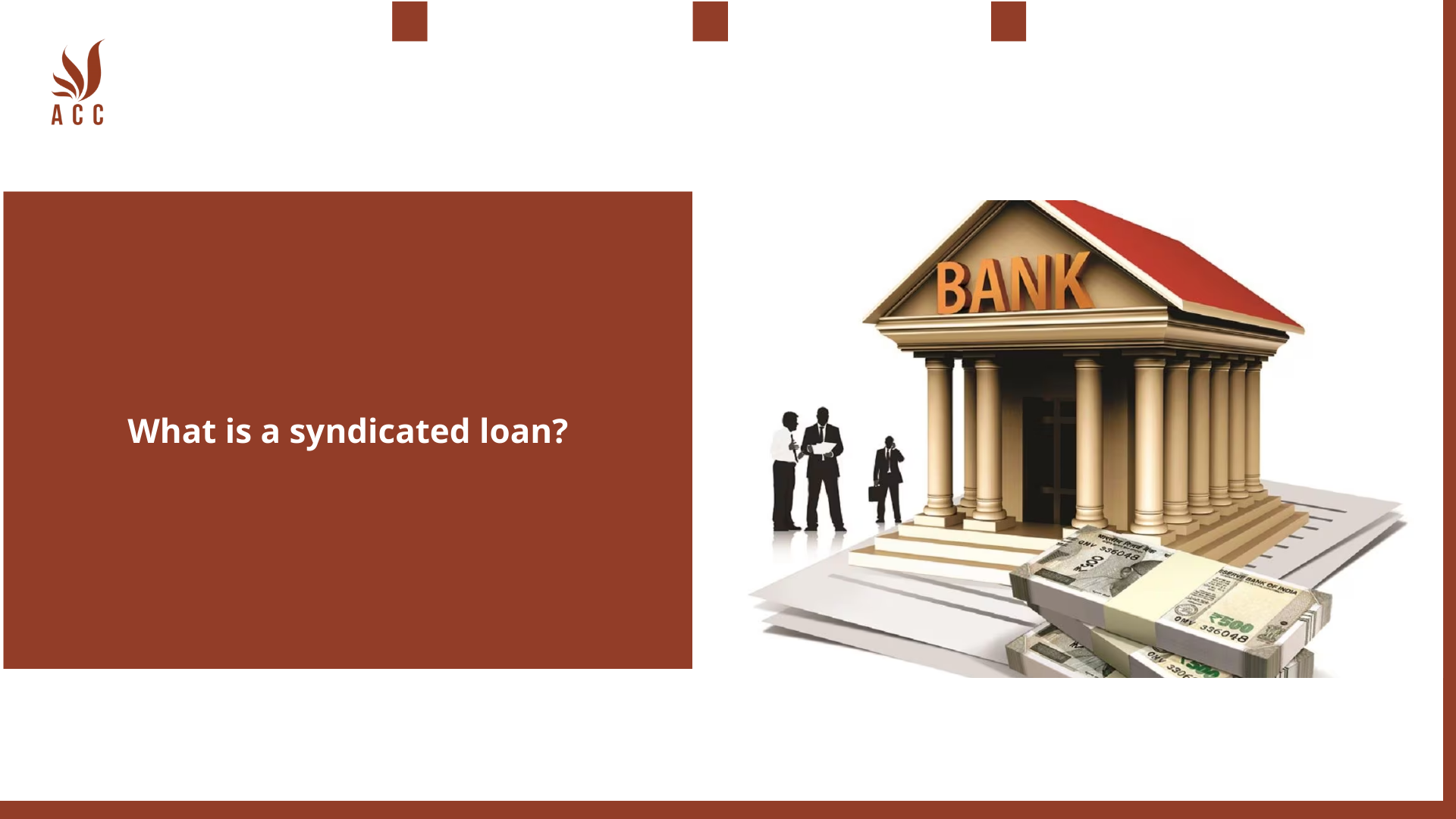
1. What is a syndicated loan?
In the realm of finance, syndicated loans stand tall as a vital instrument for raising substantial capital and spreading risk. This article delves into the world of syndicated loans, shedding light on their workings, types, and the reasons banks choose to syndicate. By the time you finish reading, you'll have a profound understanding of this financial powerhouse.
2. Syndicated Loans Unveiled
A syndicated loan is a form of financing offered by a syndicate, comprising a consortium of lenders working collaboratively to provide financial support to a borrower. These loans become essential when a project requires a substantial amount of capital beyond the capacity of a single lender or when a specialized lender with expertise in a specific asset class is needed.
Key Takeaways
Let's dissect the essentials:
- Collaborative Financing: Syndicated loans involve a group of lenders working in tandem to provide funds to a borrower.
- Diverse Borrowers: These loans cater to a wide range of borrowers, be it corporations, large-scale projects, or sovereign governments.
- Risk Mitigation: The involvement of several financial institutions spreads the risk in case the borrower defaults, as the loans often involve significant sums.
3. How Syndicated Loans Operate?
Typically, a syndicated loan features a lead bank or underwriter, known as the arranger, agent, or lead lender. This institution plays a pivotal role in the syndicate, potentially contributing a larger share of the loan or handling responsibilities like cash flow distribution and administrative tasks.
The primary objective of syndicated lending is to diversify the risk associated with borrower default across multiple lenders, banks, or institutional investors, such as pension funds and hedge funds. Given the substantial size of syndicated loans, even a single borrower defaulting can have severe consequences for a single lender. Notably, these loans often fuel large corporate takeovers in the leveraged buyout sector, relying heavily on debt financing.
Syndicated loans come in various forms, such as best-efforts syndication and dual-tranche arrangements. Interest rates can be fixed or floating, benchmarked against rates like the Secured Overnight Financing Rate (SOFR).
Types of Syndicated Loans
-
Best Efforts Syndication: In this approach, the lead bank puts forth its best efforts to assemble a syndicate for a loan, but it isn't obliged to make loans to the borrower directly. This method is commonly used when borrowers have a suboptimal credit history or during economic downturns.
-
Club Deal: Club deals are typically for loans under $150 million, involving a select group of lenders with existing relationships with the borrower. Lenders here share the loan equally, including interest rates and fees.
-
Underwritten Deal: Underwritten deals provide full guarantees from the lead bank. If no other bank joins the syndicate, the lead bank bears the responsibility for financing the loan initially. It may seek additional investors later to spread the risk.
These loans are also referred to as syndicated bank facilities, underscoring their importance in the financial landscape.
4. A Real-World Example
To put the concept into perspective, consider China's Tencent Holdings, which secured a syndicated loan of $4.65 billion in March 2017. Multiple banks, with Citigroup taking the lead role, coordinated, arranged, and underwrote this substantial loan. Such examples demonstrate the practical applications of syndicated loans in facilitating major financial endeavors.
5. Why Do Banks Syndicate Loans?
Banks opt for syndicated loans to share lending risk among a group of lenders. This approach helps mitigate the risk associated with lending to a borrower since no single bank shoulders the entire responsibility for the loan.
Assessing the Risks
Lending is inherently risky, but syndicated loans offer a more balanced approach. In a syndicate, each bank is only responsible for a fraction of the total loan amount. Therefore, if a borrower defaults on a syndicated loan, each bank is liable for its agreed-upon portion, reducing the potential loss.
Exploring Syndicated Mortgages
Beyond corporate financing, syndicated mortgages are a different breed, secured by a mortgage and involving multiple lenders. These mortgages can range from simple agreements with three parties to complex situations financing extensive real estate transactions, often supporting initial phases like planning and zoning.
6. The Bottom Line
In conclusion, syndicated loans empower a consortium of lenders to collaborate, contributing various portions of a full loan. This diversification of risk ensures that no single entity bears the brunt of borrower defaults. Understanding the dynamics of syndicated loans is vital for anyone navigating the complex world of finance.
7. Why should professionals use ACC Law Firm's capital Service?
-
Expertise in Legal Matters: ACC Law Firm specializes in legal services, providing professionals with access to experienced attorneys who can offer valuable legal guidance. Whether it's contract negotiations, intellectual property issues, employment matters, or any other legal concern, their expertise can be invaluable.
-
Tailored Legal Solutions: ACC Law Firm understands that every professional's needs are unique. They can customize their legal services to address the specific challenges and opportunities faced by professionals in different fields.
-
Risk Mitigation: Legal issues can pose significant risks to professionals and their businesses. ACC Law Firm can help identify and mitigate these risks, reducing the potential for costly legal disputes or compliance issues.
-
Resource Optimization: Professionals can save time and resources by outsourcing their legal needs to ACC Law Firm. This allows them to focus on their core competencies and business objectives, while leaving legal matters in the hands of professionals.
-
Access to a Network: ACC Law Firm may have a network of legal experts and professionals in various fields, which can be beneficial for clients seeking connections and advice beyond just legal services.
Q&A
Question 1: What is a loan, and how is it defined in the context of finance?
Answer 1: A loan is a financial arrangement in which one party, often a lender or financial institution, provides money, assets, or funds to another party, known as the borrower, with the expectation that the borrower will repay the principal amount along with interest or other agreed-upon terms over a specified period. Loans are commonly used for various purposes, including purchasing homes, financing education, or funding business operations.
Question 2: What are the key components of a loan, and how do they impact the borrowing process?
Answer 2: The key components of a loan include:
- Principal: The initial amount borrowed, which must be repaid.
- Interest: The cost of borrowing money, expressed as a percentage of the principal, which the borrower must repay in addition to the principal.
- Term: The duration over which the loan is repaid, which can range from months to decades.
- Repayment Schedule: The plan outlining how the borrower will repay the loan, typically through monthly installments.
- Collateral (if applicable): An asset used to secure the loan, which the lender can seize if the borrower defaults.
These components, along with the loan's purpose and interest rate, influence the terms and conditions of the loan.
Question 3: What are the various types of loans available, and how do they differ in terms of purpose and terms?
Answer 3: There are various types of loans, including:
- Personal Loans: Unsecured loans used for various personal expenses, such as debt consolidation or unexpected medical bills.
- Mortgage Loans: Loans specifically for purchasing real estate or properties.
- Auto Loans: Loans used to finance the purchase of a vehicle.
- Student Loans: Loans designed to cover educational expenses, often with deferred payment options.
- Business Loans: Loans to fund or expand a business, including working capital, equipment financing, and startup loans.
- Secured Loans: Loans backed by collateral, such as home equity loans or car title loans.
- Unsecured Loans: Loans that don't require collateral but may have higher interest rates.
- Payday Loans: Short-term, high-interest loans often used for emergencies, with quick repayment terms.
Each type of loan serves a specific purpose and has unique terms and conditions.
Question 4: How do interest rates, credit scores, and credit history influence a borrower's eligibility for a loan and the cost of borrowing?
Answer 4: Interest rates, credit scores, and credit history play a crucial role in a borrower's eligibility for a loan and the cost of borrowing. Lenders assess a borrower's creditworthiness to determine the interest rate and loan terms. A higher credit score and positive credit history typically result in lower interest rates and more favorable loan terms. Conversely, a lower credit score or poor credit history may lead to higher interest rates and limited loan options. Lenders use these factors to manage risk and provide loans to applicants who are more likely to repay as agreed.
Nội dung bài viết:






Bình luận